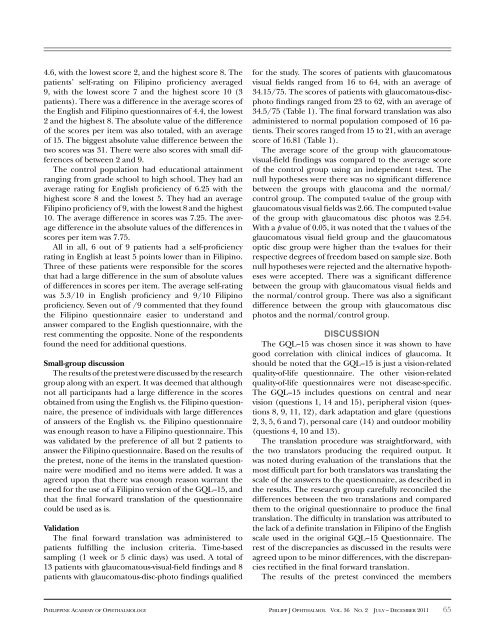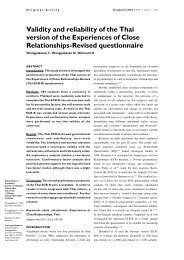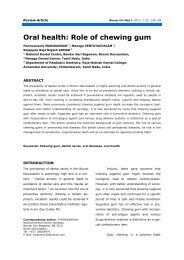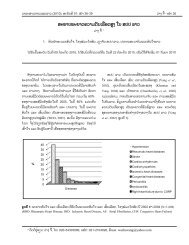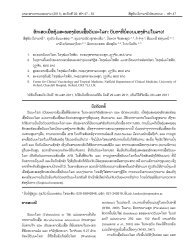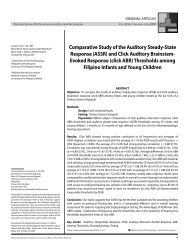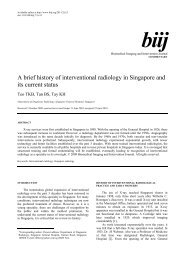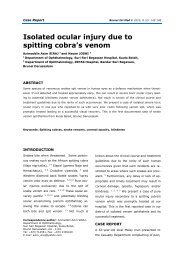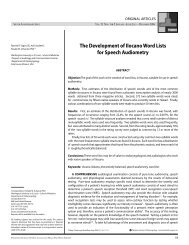Translation and validation of a Filipino version of the glaucoma ...
Translation and validation of a Filipino version of the glaucoma ...
Translation and validation of a Filipino version of the glaucoma ...
You also want an ePaper? Increase the reach of your titles
YUMPU automatically turns print PDFs into web optimized ePapers that Google loves.
4.6, with <strong>the</strong> lowest score 2, <strong>and</strong> <strong>the</strong> highest score 8. Thepatients’ self-rating on <strong>Filipino</strong> pr<strong>of</strong>iciency averaged9, with <strong>the</strong> lowest score 7 <strong>and</strong> <strong>the</strong> highest score 10 (3patients). There was a difference in <strong>the</strong> average scores <strong>of</strong><strong>the</strong> English <strong>and</strong> <strong>Filipino</strong> questionnaires <strong>of</strong> 4.4, <strong>the</strong> lowest2 <strong>and</strong> <strong>the</strong> highest 8. The absolute value <strong>of</strong> <strong>the</strong> difference<strong>of</strong> <strong>the</strong> scores per item was also totaled, with an average<strong>of</strong> 15. The biggest absolute value difference between <strong>the</strong>two scores was 31. There were also scores with small differences<strong>of</strong> between 2 <strong>and</strong> 9.The control population had educational attainmentranging from grade school to high school. They had anaverage rating for English pr<strong>of</strong>iciency <strong>of</strong> 6.25 with <strong>the</strong>highest score 8 <strong>and</strong> <strong>the</strong> lowest 5. They had an average<strong>Filipino</strong> pr<strong>of</strong>iciency <strong>of</strong> 9, with <strong>the</strong> lowest 8 <strong>and</strong> <strong>the</strong> highest10. The average difference in scores was 7.25. The averagedifference in <strong>the</strong> absolute values <strong>of</strong> <strong>the</strong> differences inscores per item was 7.75.All in all, 6 out <strong>of</strong> 9 patients had a self-pr<strong>of</strong>iciencyrating in English at least 5 points lower than in <strong>Filipino</strong>.Three <strong>of</strong> <strong>the</strong>se patients were responsible for <strong>the</strong> scoresthat had a large difference in <strong>the</strong> sum <strong>of</strong> absolute values<strong>of</strong> differences in scores per item. The average self-ratingwas 5.3/10 in English pr<strong>of</strong>iciency <strong>and</strong> 9/10 <strong>Filipino</strong>pr<strong>of</strong>iciency. Seven out <strong>of</strong> /9 commented that <strong>the</strong>y found<strong>the</strong> <strong>Filipino</strong> questionnaire easier to underst<strong>and</strong> <strong>and</strong>answer compared to <strong>the</strong> English questionnaire, with <strong>the</strong>rest commenting <strong>the</strong> opposite. None <strong>of</strong> <strong>the</strong> respondentsfound <strong>the</strong> need for additional questions.Small-group discussionThe results <strong>of</strong> <strong>the</strong> pretest were discussed by <strong>the</strong> researchgroup along with an expert. It was deemed that althoughnot all participants had a large difference in <strong>the</strong> scoresobtained from using <strong>the</strong> English vs. <strong>the</strong> <strong>Filipino</strong> questionnaire,<strong>the</strong> presence <strong>of</strong> individuals with large differences<strong>of</strong> answers <strong>of</strong> <strong>the</strong> English vs. <strong>the</strong> <strong>Filipino</strong> questionnairewas enough reason to have a <strong>Filipino</strong> questionnaire. Thiswas validated by <strong>the</strong> preference <strong>of</strong> all but 2 patients toanswer <strong>the</strong> <strong>Filipino</strong> questionnaire. Based on <strong>the</strong> results <strong>of</strong><strong>the</strong> pretest, none <strong>of</strong> <strong>the</strong> items in <strong>the</strong> translated questionnairewere modified <strong>and</strong> no items were added. It was aagreed upon that <strong>the</strong>re was enough reason warrant <strong>the</strong>need for <strong>the</strong> use <strong>of</strong> a <strong>Filipino</strong> <strong>version</strong> <strong>of</strong> <strong>the</strong> GQL–15, <strong>and</strong>that <strong>the</strong> final forward translation <strong>of</strong> <strong>the</strong> questionnairecould be used as is.ValidationThe final forward translation was administered topatients fulfilling <strong>the</strong> inclusion criteria. Time-basedsampling (1 week or 5 clinic days) was used. A total <strong>of</strong>13 patients with <strong>glaucoma</strong>tous-visual-field findings <strong>and</strong> 8patients with <strong>glaucoma</strong>tous-disc-photo findings qualifiedfor <strong>the</strong> study. The scores <strong>of</strong> patients with <strong>glaucoma</strong>tousvisual fields ranged from 16 to 64, with an average <strong>of</strong>34.15/75. The scores <strong>of</strong> patients with <strong>glaucoma</strong>tous-discphot<strong>of</strong>indings ranged from 23 to 62, with an average <strong>of</strong>34.5/75 (Table 1). The final forward translation was alsoadministered to normal population composed <strong>of</strong> 16 patients.Their scores ranged from 15 to 21, with an averagescore <strong>of</strong> 16.81 (Table 1).The average score <strong>of</strong> <strong>the</strong> group with <strong>glaucoma</strong>tousvisual-fieldfindings was compared to <strong>the</strong> average score<strong>of</strong> <strong>the</strong> control group using an independent t-test. Thenull hypo<strong>the</strong>ses were <strong>the</strong>re was no significant differencebetween <strong>the</strong> groups with <strong>glaucoma</strong> <strong>and</strong> <strong>the</strong> normal/control group. The computed t-value <strong>of</strong> <strong>the</strong> group with<strong>glaucoma</strong>tous visual fields was 2.66. The computed t-value<strong>of</strong> <strong>the</strong> group with <strong>glaucoma</strong>tous disc photos was 2.54.With a p value <strong>of</strong> 0.05, it was noted that <strong>the</strong> t values <strong>of</strong> <strong>the</strong><strong>glaucoma</strong>tous visual field group <strong>and</strong> <strong>the</strong> <strong>glaucoma</strong>tousoptic disc group were higher than <strong>the</strong> t-values for <strong>the</strong>irrespective degrees <strong>of</strong> freedom based on sample size. Bothnull hypo<strong>the</strong>ses were rejected <strong>and</strong> <strong>the</strong> alternative hypo<strong>the</strong>seswere accepted. There was a significant differencebetween <strong>the</strong> group with <strong>glaucoma</strong>tous visual fields <strong>and</strong><strong>the</strong> normal/control group. There was also a significantdifference between <strong>the</strong> group with <strong>glaucoma</strong>tous discphotos <strong>and</strong> <strong>the</strong> normal/control group.DISCUSSIONThe GQL–15 was chosen since it was shown to havegood correlation with clinical indices <strong>of</strong> <strong>glaucoma</strong>. Itshould be noted that <strong>the</strong> GQL–15 is just a vision-relatedquality-<strong>of</strong>-life questionnaire. The o<strong>the</strong>r vision-relatedquality-<strong>of</strong>-life questionnaires were not disease-specific.The GQL–15 includes questions on central <strong>and</strong> nearvision (questions 1, 14 <strong>and</strong> 15), peripheral vision (questions8, 9, 11, 12), dark adaptation <strong>and</strong> glare (questions2, 3, 5, 6 <strong>and</strong> 7), personal care (14) <strong>and</strong> outdoor mobility(questions 4, 10 <strong>and</strong> 13).The translation procedure was straightforward, with<strong>the</strong> two translators producing <strong>the</strong> required output. Itwas noted during evaluation <strong>of</strong> <strong>the</strong> translations that <strong>the</strong>most difficult part for both translators was translating <strong>the</strong>scale <strong>of</strong> <strong>the</strong> answers to <strong>the</strong> questionnaire, as described in<strong>the</strong> results. The research group carefully reconciled <strong>the</strong>differences between <strong>the</strong> two translations <strong>and</strong> compared<strong>the</strong>m to <strong>the</strong> original questionnaire to produce <strong>the</strong> finaltranslation. The difficulty in translation was attributed to<strong>the</strong> lack <strong>of</strong> a definite translation in <strong>Filipino</strong> <strong>of</strong> <strong>the</strong> Englishscale used in <strong>the</strong> original GQL–15 Questionnaire. Therest <strong>of</strong> <strong>the</strong> discrepancies as discussed in <strong>the</strong> results wereagreed upon to be minor differences, with <strong>the</strong> discrepanciesrectified in <strong>the</strong> final forward translation.The results <strong>of</strong> <strong>the</strong> pretest convinced <strong>the</strong> membersPhilippine Academy <strong>of</strong> Ophthalmology Philipp J Ophthalmol Vol. 36 No. 2 July – December 201165


